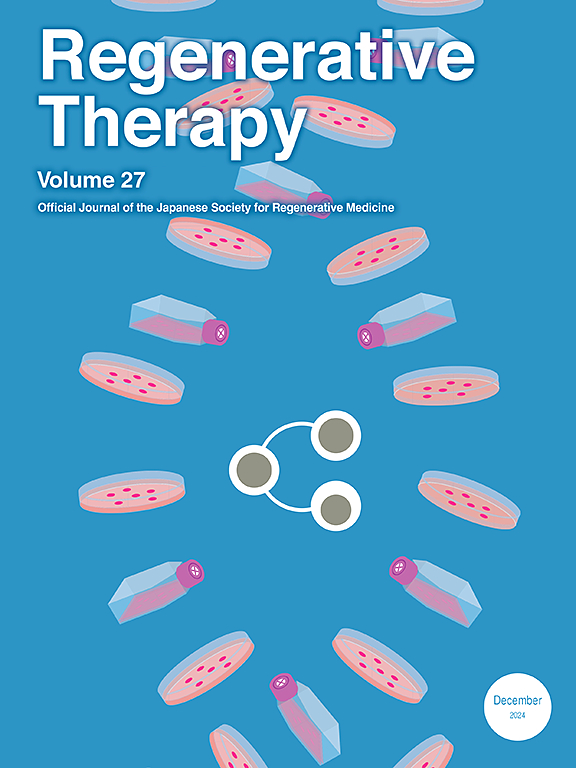Subretinal suspensions of hiPSC-derived retinal pigment epithelium cells form functional monolayers in NOD-SCID mice facilitating treatment of advanced retinal diseases
IF 3.5
3区 环境科学与生态学
Q3 CELL & TISSUE ENGINEERING
引用次数: 0
Abstract
Introduction
Transplantation of human induced pluripotent stem cells derived retinal pigment epithelium (hiPSC-RPE) is regarded as one of the most promising strategies for advanced retinal degenerative diseases leading to blindness, such as age-related macular degeneration. Despite its therapeutic potential, this approach is encumbered by critical challenges, notably the survival of donor RPE cells post-transplantation and the successful reconstruction of a functional RPE layer.
Methods
With our previously reported strategy, abundant hiPSC-RPEs were generated from human induced pluripotent stem cells. These cells were characterized in vitro by morphology, marker expression and function. Further, hiPSC-RPE cell suspensions were injected into the eyes of NOD-SCID mice. Animals were monitored by optical coherence tomography screening and color fundus imaging to evaluate the survival of hiPSC-RPEs. Polarity, maturity, integration and phagocytosis of hiPSC-RPEs were analyzed histologically.
Results
hiPSC-RPE cells exhibited a cobblestone morphology with abundant microvilli and tight junctions, expressed RPE specific molecular markers, and possessed ability to phagocytize photoreceptor outer segments (POS), thereby resembling the characteristics of the native human RPE cells. Following transplantation into NOD-SCID mice, the cells survived for the 8-week testing period and formed a highly organized monolayer in regions with an intact Bruch's membrane (BM) in the host retina. The reconstructed RPE layer expressed both human-specific and RPE-specific markers with POS phagocytic function. No severe adverse effects, such as malignant tumors or infections, were observed.
Conclusions
These findings demonstrate that hiPSC-RPE suspensions can survive and form RPE monolayers with morphological and functional features analogous to those of native human RPE cells in the host retina with a healthy BM. Our study may facilitate the development of cell-based therapies for treatment of advanced retinal degenerations.
在NOD-SCID小鼠中,hipsc源性视网膜色素上皮细胞的视网膜下悬液形成功能单层,促进晚期视网膜疾病的治疗
人类诱导多能干细胞来源的视网膜色素上皮(hiPSC-RPE)移植被认为是治疗晚期视网膜退行性疾病(如年龄相关性黄斑变性)导致失明的最有前途的策略之一。尽管具有治疗潜力,但这种方法仍受到一些关键挑战的阻碍,特别是移植后供体RPE细胞的存活和功能RPE层的成功重建。方法利用我们之前报道的策略,从人诱导多能干细胞中产生大量的hiPSC-RPEs。对这些细胞进行了体外形态学、标志物表达和功能表征。进一步,将hiPSC-RPE细胞悬液注射到NOD-SCID小鼠的眼睛中。通过光学相干断层扫描和彩色眼底成像对动物进行监测,以评估hipsc - rpe的存活。组织学分析hiPSC-RPEs的极性、成熟度、整合和吞噬作用。结果shipsc -RPE细胞呈鹅卵石状,微绒毛丰富,连接紧密,表达RPE特异性分子标记,具有吞噬光感受器外段(POS)的能力,与天然人RPE细胞特征相似。在移植到NOD-SCID小鼠体内后,这些细胞存活了8周,并在宿主视网膜中具有完整布鲁氏膜(BM)的区域形成了高度组织的单层。重构的RPE层同时表达具有POS吞噬功能的人类特异性和RPE特异性标记物。未观察到严重的不良反应,如恶性肿瘤或感染。结论hiPSC-RPE悬浮液可在健康基底细胞宿主视网膜中存活并形成具有类似于天然人RPE细胞形态和功能特征的RPE单层细胞。我们的研究可能会促进细胞治疗晚期视网膜变性的发展。
本文章由计算机程序翻译,如有差异,请以英文原文为准。
求助全文
约1分钟内获得全文
求助全文
来源期刊

Regenerative Therapy
Engineering-Biomedical Engineering
CiteScore
6.00
自引率
2.30%
发文量
106
审稿时长
49 days
期刊介绍:
Regenerative Therapy is the official peer-reviewed online journal of the Japanese Society for Regenerative Medicine.
Regenerative Therapy is a multidisciplinary journal that publishes original articles and reviews of basic research, clinical translation, industrial development, and regulatory issues focusing on stem cell biology, tissue engineering, and regenerative medicine.
 求助内容:
求助内容: 应助结果提醒方式:
应助结果提醒方式:


